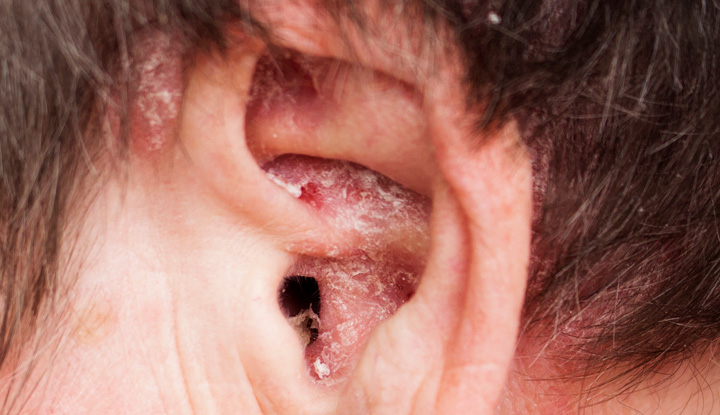Otitis externa eczema, also known as eczematous otitis externa or ear canal eczema, refers to chronic inflammatory conditions affecting the skin of the external auditory canal, often linked to underlying dermatological disorders such as atopic dermatitis, seborrheic dermatitis, or contact dermatitis. This condition manifests as persistent itching, scaling, erythema, and discomfort in the outer ear, and is frequently misdiagnosed due to its overlap with infectious otitis externa.

Pathophysiology of Eczematous Otitis Externa
Eczema within the ear canal arises due to compromised skin barrier function, which makes the canal vulnerable to irritation, allergens, and microbial colonization. Chronic inflammation leads to hyperkeratosis, fissuring, and increased susceptibility to secondary infections.
Common Causes of Otitis Externa Eczema
Atopic Dermatitis
A chronic inflammatory skin disorder marked by dry, itchy skin and heightened immune reactivity. Patients often present with bilateral ear canal involvement, associated with a history of asthma, hay fever, or childhood eczema.
Seborrheic Dermatitis
Characterized by greasy scales and erythema, seborrheic dermatitis frequently affects the auricle, external canal, and adjacent scalp. Malassezia yeast overgrowth is often implicated.
Allergic Contact Dermatitis
Resulting from hypersensitivity to topical agents (e.g., ear drops, shampoos, hearing aid components), this form of eczema manifests with intense itching and weeping lesions.
Irritant Contact Dermatitis
Caused by repetitive trauma or exposure to harsh cleaning agents, it leads to non-allergic inflammation and peeling.
Clinical Presentation: Signs and Symptoms
Typical Symptoms
- Pruritus (itching): Primary and often intense, leading to frequent scratching
- Dryness and flaking: Skin desquamation within the external auditory canal
- Erythema and edema: Varying degrees of redness and swelling
- Otorrhea: Clear or serous discharge in some cases
- Crusting and fissures: Especially in severe or chronic presentations
- Reduced hearing: From canal obstruction due to scaling or inflammation
Diagnosis of Eczematous Otitis Externa
Clinical Evaluation
Diagnosis is primarily clinical, based on:
- History of skin disorders (e.g., eczema, psoriasis)
- Examination findings such as dry, inflamed canal skin
- Absence of acute infection unless secondary bacterial involvement occurs
Differential Diagnoses
| Condition | Distinguishing Features |
|---|---|
| Infectious otitis externa | Purulent discharge, pain with tragus pressure |
| Psoriasis | Silvery scales, involvement beyond the ear |
| Otomycosis | Presence of fungal spores, black/white debris |
Investigations (If Indicated)
- Patch testing: For suspected allergic contact dermatitis
- Swab for culture: If secondary infection is suspected
- Biopsy: Rarely needed unless malignancy is a concern
Treatment Strategies for Otitis Externa Eczema
General Management Principles
- Avoid exacerbating factors such as excessive cleaning, irritants, and moisture
- Educate patients about chronic nature and flare-up triggers
Topical Therapy
Corticosteroid Ear Drops
- Hydrocortisone, betamethasone, or mometasone ear preparations to reduce inflammation
- Should be used cautiously and for limited periods to avoid thinning of the canal skin
Combination Preparations
- Steroid drops combined with antibiotics (e.g., neomycin, ciprofloxacin) if secondary infection is suspected
Emollients and Barrier Repair Agents
- Olive oil, mineral oil, or specialized ceramide-based creams for canal hydration
- Restore skin integrity and reduce flare-ups
Antifungal Agents (If Seborrheic)
- Clotrimazole or ketoconazole for suspected yeast involvement
- Often used alongside low-potency steroids
Systemic Therapy
- Reserved for widespread dermatitis or failure of topical therapy
- Includes oral antihistamines, systemic steroids, or immunomodulators in atopic dermatitis cases
Prevention and Long-Term Management
Lifestyle and Hygiene Recommendations
- Avoid inserting objects like cotton swabs or hearing aids during flare-ups
- Maintain ear dryness and avoid exposure to harsh soaps and shampoos
- Use hypoallergenic personal care products
Dermatologic Support
- Patients with underlying atopic or seborrheic dermatitis benefit from coordinated care with dermatologists
- Long-term skin care regimens reduce recurrence and severity
Complications of Untreated Eczema in the Ear
- Canal stenosis from repeated inflammation and scarring
- Superimposed bacterial or fungal infections
- Persistent hearing impairment due to debris accumulation
- Chronic pain or discomfort, especially in cases with fissuring
Frequently Asked Questions:
What causes eczema in the ear canal?
It is typically triggered by underlying skin conditions like atopic or seborrheic dermatitis, or contact allergens.
Can otitis externa eczema become infected?
Yes. Scratching or poor hygiene can introduce bacteria or fungi, leading to secondary infections.
How is eczema in the ear different from swimmer’s ear?
Eczema is primarily inflammatory and chronic, while swimmer’s ear (bacterial otitis externa) is typically acute and painful.
Is it safe to use steroid ear drops long-term?
Long-term use is not recommended due to the risk of thinning the skin. Use under medical supervision during flares only.
Can hearing aids cause ear eczema?
Yes, due to pressure, moisture, and allergic reaction to components. Consider hypoallergenic molds and proper cleaning.
Otitis externa eczema represents a chronic, often relapsing inflammatory condition of the ear canal linked to various dermatologic disorders. Successful management hinges on identifying the underlying cause, avoiding triggers, and employing targeted topical therapies. With proper diagnosis and patient education, symptoms can be effectively controlled, improving both comfort and quality of life.